A Deep Learning Approach Based on Novel Multi-Feature Fusion for Power Load Prediction
Abstract
1. Introduction
1.1. Background and Challenges
1.2. Knowledge Gaps
1.3. The Model Proposed in This Work
1.4. Novelty and Contributions
2. Literature Review
3. Methodology
3.1. Time-Varying Filter-Based EMD
3.2. Sample Entropy
3.3. Convolutional Neural Network
3.4. Bi-Directional Long Short-Term Memory
3.5. The Proposed Hybrid Model in This Study
| Algorithm 1 The pseudocode of the proposed model |
Input: Power load datasets: . The initial hyperparameters . Output: Forecasting values: . Accuracy: MAE, , RMSE and MAPE Optimal hyperparameters: .
|
4. Case Studies and Experimental Results
4.1. Data Sources and Descriptions
4.2. Performance Metrics
4.3. Experiment I: Online Feature Extraction Process Simulation
4.4. Experiment II: Transfer Learning Process Simulation
5. Discussion
6. Conclusions
Author Contributions
Funding
Data Availability Statement
Conflicts of Interest
References
- Guo, X.; Chen, L.; Wang, J.; Liao, L. The impact of disposability characteristics on carbon efficiency from a potential emissions reduction perspective. J. Clean. Prod. 2023, 408, 137180. [Google Scholar] [CrossRef]
- Asanov, M.; Asanova, S.; Safaraliev, M.; Zicmane, I.; Beryozkina, S.; Suerkulov, S. Design methodology of intelligent autonomous distributed hybrid power complexes with renewable energy sources. Int. J. Hydrogen Energy 2023, 48, 31468–31478. [Google Scholar] [CrossRef]
- Pawar, P.; TarunKumar, M.; Vittal K., P. An IoT based Intelligent Smart Energy Management System with accurate forecasting and load strategy for renewable generation. Measurement 2020, 152, 107187. [Google Scholar] [CrossRef]
- Vardhan, B.S.; Khedkar, M.; Srivastava, I.; Patro, S.K. Impact of integrated classifier—Regression mapped short term load forecasting on power system management in a grid connected multi energy systems. Electr. Power Syst. Res. 2024, 230, 110222. [Google Scholar] [CrossRef]
- Telle, J.S.; Upadhaya, A.; Schönfeldt, P.; Steens, T.; Hanke, B.; von Maydell, K. Probabilistic net load forecasting framework for application in distributed integrated renewable energy systems. Energy Rep. 2024, 11, 2535–2553. [Google Scholar] [CrossRef]
- Pramanik, A.S.; Sepasi, S.; Nguyen, T.L.; Roose, L. An ensemble-based approach for short-term load forecasting for buildings with high proportion of renewable energy sources. Energy Build. 2024, 308, 113996. [Google Scholar] [CrossRef]
- Wei, G.; He, J.; Zhang, Y. Application of the Unascertained Number in the Improvement of the Regressive Load Forecasting Model. High Volt. Eng. 2005, 31, 73–75. [Google Scholar]
- Smyl, S. A hybrid method of exponential smoothing and recurrent neural networks for time series forecasting. Int. J. Forecast. 2020, 36, 75–85. [Google Scholar] [CrossRef]
- Liu, Y.; Han, M.; Guo, J.; Liangli, S.U. Short-term electric load forecasting based on DBSCAN-ARIMA method. J. Beijing Inf. Sci. Technol. Univ. 2019, 34, 84–87. [Google Scholar]
- Tang, T.; Jiang, W.; Zhang, H.; Nie, J.; Xiong, Z.; Wu, X.; Feng, W. GM(1,1) based improved seasonal index model for monthly electricity consumption forecasting. Energy 2022, 252, 124041. [Google Scholar] [CrossRef]
- Chen, Y.; Xiao, C.; Yang, S.; Yang, Y.; Wang, W. Research on long term power load grey combination forecasting based on fuzzy support vector machine. Comput. Electr. Eng. 2024, 116, 109205. [Google Scholar] [CrossRef]
- Loizidis, S.; Kyprianou, A.; Georghiou, G.E. Electricity market price forecasting using ELM and Bootstrap analysis: A case study of the German and Finnish Day-Ahead markets. Appl. Energy 2024, 363, 123058. [Google Scholar] [CrossRef]
- Zhu, J.; Yang, Z.; Guo, Y.; Yu, K.; Zhang, J.; Mu, X. Deep Learning Applications in Power System Load Forecasting: A Survey. J. Zhengzhou Univ. Eng. Sci. 2022, 31, 3. [Google Scholar]
- Zhu, L.; Xun, Z.; Wang, Y.; Cui, Q.; Chen, Y.; Lou, J. Short-term Power Load Forecasting Based on CNN-BiLSTM. Power Syst. Technol. 2021, 45, 4532–4539. [Google Scholar]
- Wan, A.; Chang, Q.; AL-Bukhaiti, K.; He, J. Short-term power load forecasting for combined heat and power using CNN-LSTM enhanced by attention mechanism. Energy 2023, 282, 128274. [Google Scholar] [CrossRef]
- Michael, N.E.; Bansal, R.C.; Ismail, A.A.A.; Elnady, A.; Hasan, S. A cohesive structure of Bi-directional long-short-term memory (BiLSTM) -GRU for predicting hourly solar radiation. Renew. Energy 2024, 222, 119943. [Google Scholar] [CrossRef]
- Shao, Z.; Zheng, Q.; Liu, C.; Gao, S.; Wang, G.; Chu, Y. A feature extraction- and ranking-based framework for electricity spot price forecasting using a hybrid deep neural network. Electr. Power Syst. Res. 2021, 200, 107453. [Google Scholar] [CrossRef]
- Mounir, N.; Ouadi, H.; Jrhilifa, I. Short-term electric load forecasting using an EMD-BI-LSTM approach for smart grid energy management system. Energy Build. 2023, 288, 113022. [Google Scholar] [CrossRef]
- Yue, W.; Liu, Q.; Ruan, Y.; Qian, F.; Meng, H. A prediction approach with mode decomposition-recombination technique for short-term load forecasting. Sustain. Cities Soc. 2022, 85, 104034. [Google Scholar] [CrossRef]
- Gao, X.; Guo, W.; Mei, C.; Sha, J.; Guo, Y.; Sun, H. Short-term wind power forecasting based on SSA-VMD-LSTM. Energy Rep. 2023, 9, 335–344. [Google Scholar] [CrossRef]
- Xiong, D.; Fu, W.; Wang, K.; Fang, P.; Chen, T.; Zou, F. A blended approach incorporating TVFEMD, PSR, NNCT-based multi-model fusion and hierarchy-based merged optimization algorithm for multi-step wind speed prediction. Energy Convers. Manag. 2021, 230, 113680. [Google Scholar] [CrossRef]
- Zhang, W.; He, Y.; Yang, S. A multi-step probability density prediction model based on gaussian approximation of quantiles for offshore wind power. Renew. Energy 2023, 202, 992–1011. [Google Scholar] [CrossRef]
- Ye, R.; Dai, Q. A novel transfer learning framework for time series forecasting. Knowl.-Based Syst. 2018, 156, 74–99. [Google Scholar] [CrossRef]
- Li, K.; Li, Z.; Huang, C.; Ai, Q. Online transfer learning-based residential demand response potential forecasting for load aggregator. Appl. Energy 2024, 358, 122631. [Google Scholar] [CrossRef]
- Wei, N.; Yin, C.; Yin, L.; Tan, J.; Liu, J.; Wang, S.; Qiao, W.; Zeng, F. Short-term load forecasting based on WM algorithm and transfer learning model. Appl. Energy 2024, 353, 122087. [Google Scholar] [CrossRef]
- Yuan, Y.; Chen, Z.; Wang, Z.; Sun, Y.; Chen, Y. Attention mechanism-based transfer learning model for day-ahead energy demand forecasting of shopping mall buildings. Energy 2023, 270, 126878. [Google Scholar] [CrossRef]
- Yang, Q.; Lin, Y.; Kuang, S.; Wang, D. A novel short-term load forecasting approach for data-poor areas based on K-MIFS-XGBoost and transfer-learning. Electr. Power Syst. Res. 2024, 229, 110151. [Google Scholar] [CrossRef]
- Li, H.; Li, Z.; Mo, W. A time varying filter approach for empirical mode decomposition. Signal Process. 2017, 138, 146–158. [Google Scholar] [CrossRef]
- Richman, J.S.; Randall, M.J. Physiological time-series analysis using approximate entropy and sample entropy. Am. J. Physiol. Heart Circ. Physiol. 2000, 278, H2039. [Google Scholar] [CrossRef]
- Rafi, S.H.; Nahid-Al-Masood; Deeba, S.R.; Hossain, E. A Short-Term Load Forecasting Method Using Integrated CNN and LSTM Network. IEEE Access 2021, 9, 32436–32448. [Google Scholar] [CrossRef]
- Michael, N.E.; Hasan, S.; Al-Durra, A.; Mishra, M. Short-term solar irradiance forecasting based on a novel Bayesian optimized deep Long Short-Term Memory neural network. Appl. Energy 2022, 324, 119727. [Google Scholar] [CrossRef]
- Zhang, X.Y.; Watkins, C.; Kuenzel, S. Multi-quantile recurrent neural network for feeder-level probabilistic energy disaggregation considering roof-top solar energy. Eng. Appl. Artif. Intell. 2022, 110, 104707. [Google Scholar] [CrossRef]
- Wang, J.; Wang, H.; Wang, H.; Zhang, Z. Short-term Power Load Prediction of Bidirectional LSTM with ISSA Optimization Attention Mechanism. Proc.-Csu-Epsa 2022, 34, 111–117. [Google Scholar]
- de Almeida, F.A.; Romao, E.L.; Gomes, G.F.; de Freitas Gomes, J.H.; de Paiva, A.P.; Miranda Filho, J.; Balestrassi, P.P. Combining machine learning techniques with Kappa–Kendall indexes for robust hard-cluster assessment in substation pattern recognition. Electr. Power Syst. Res. 2022, 206, 107778. [Google Scholar] [CrossRef]

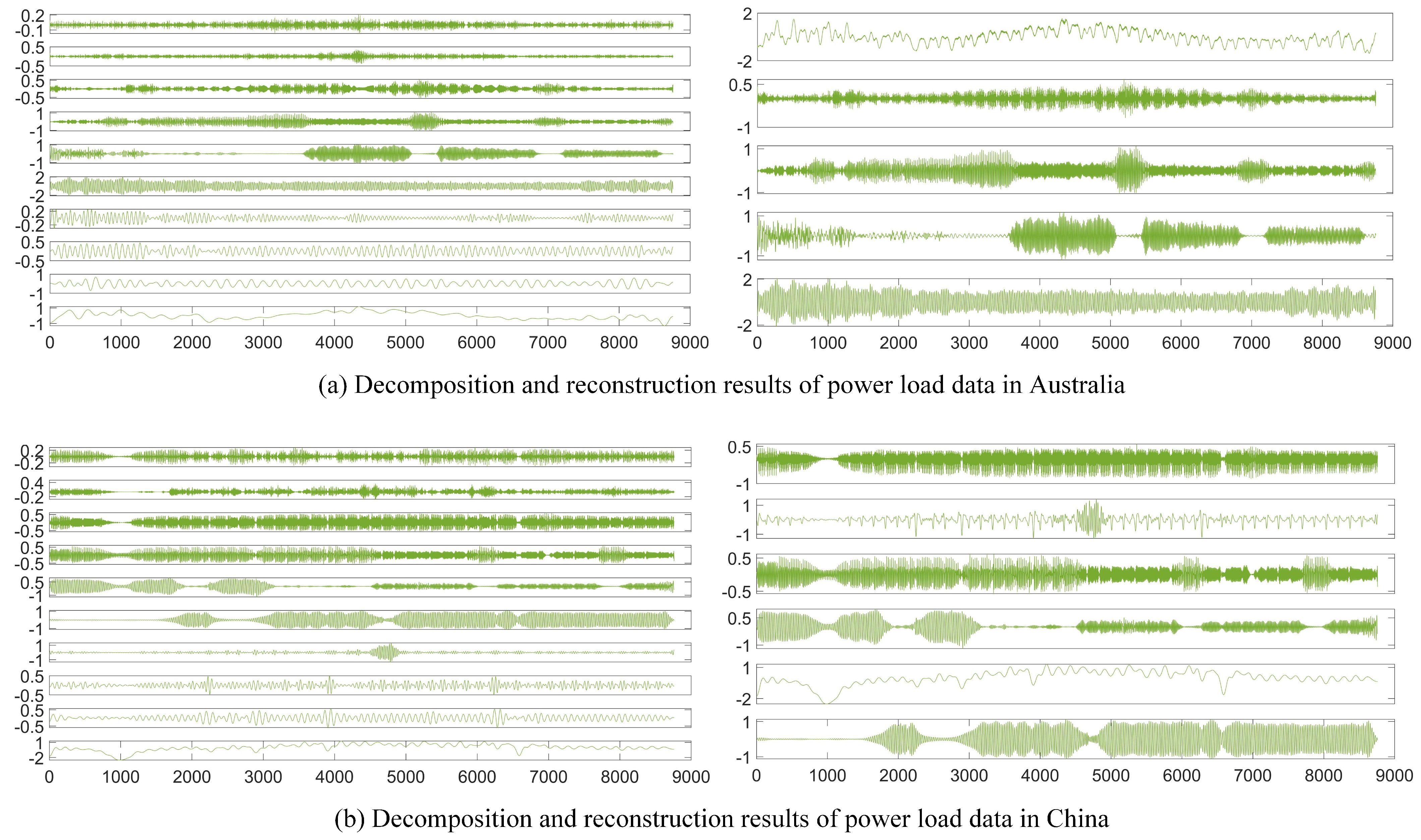
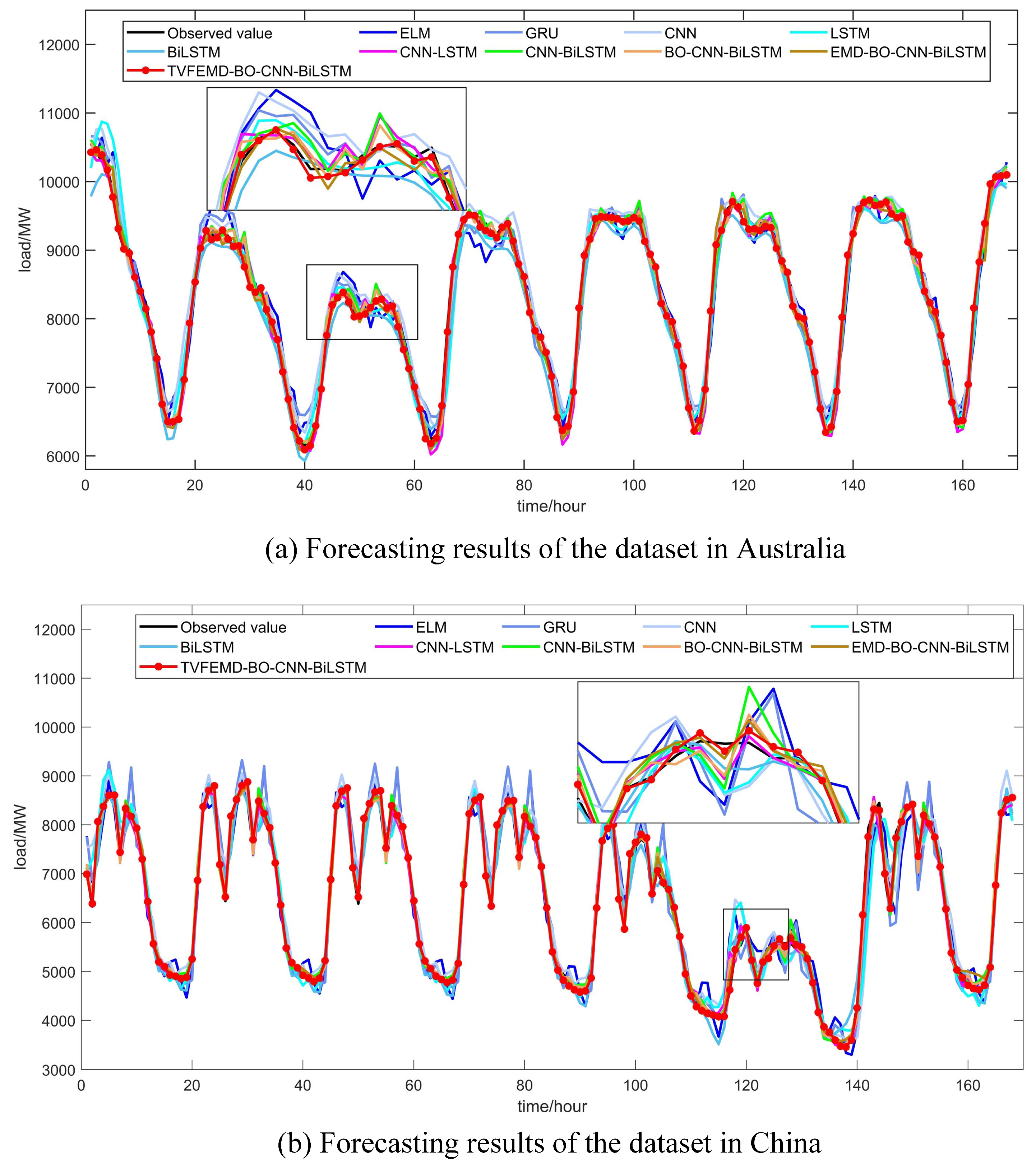
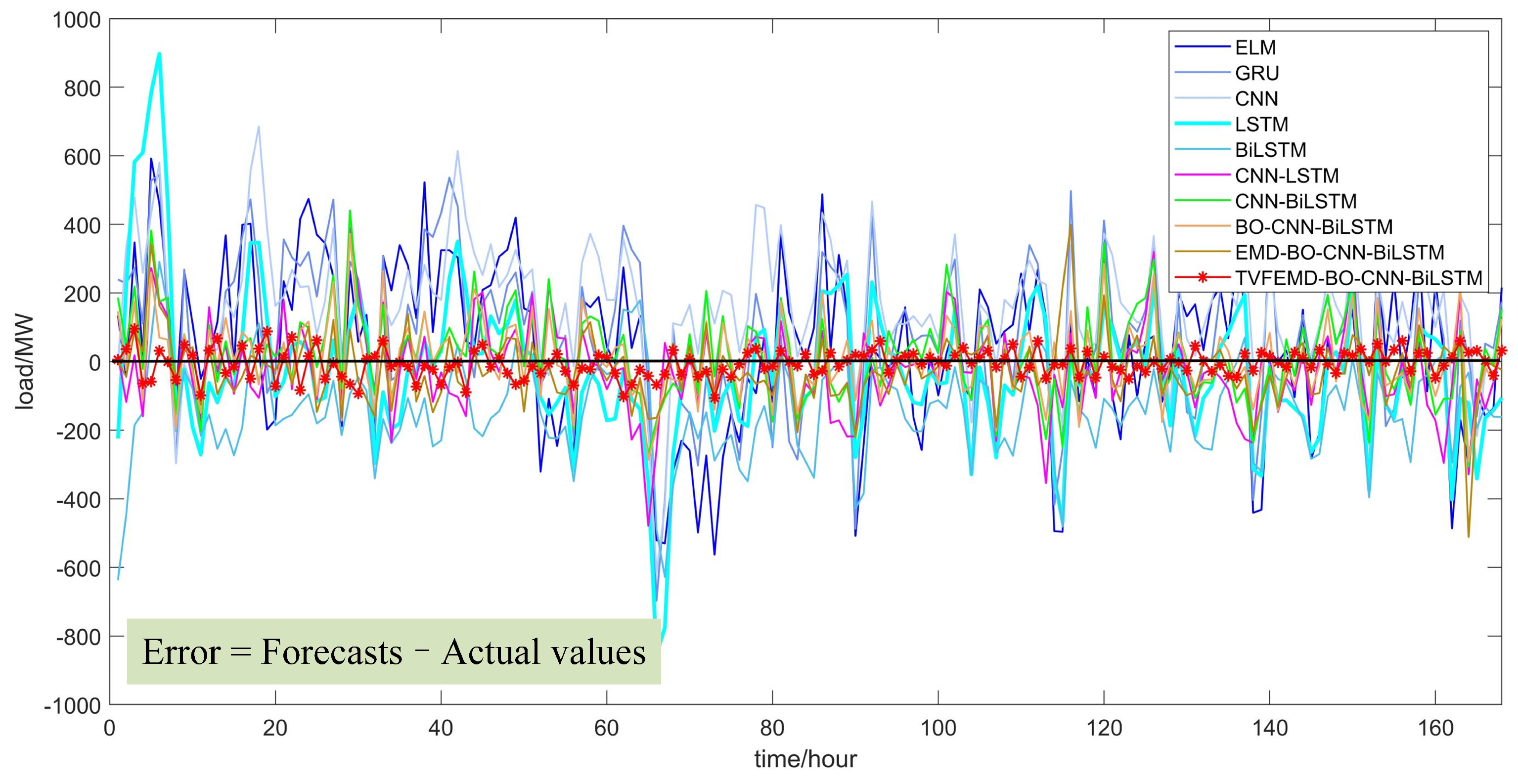
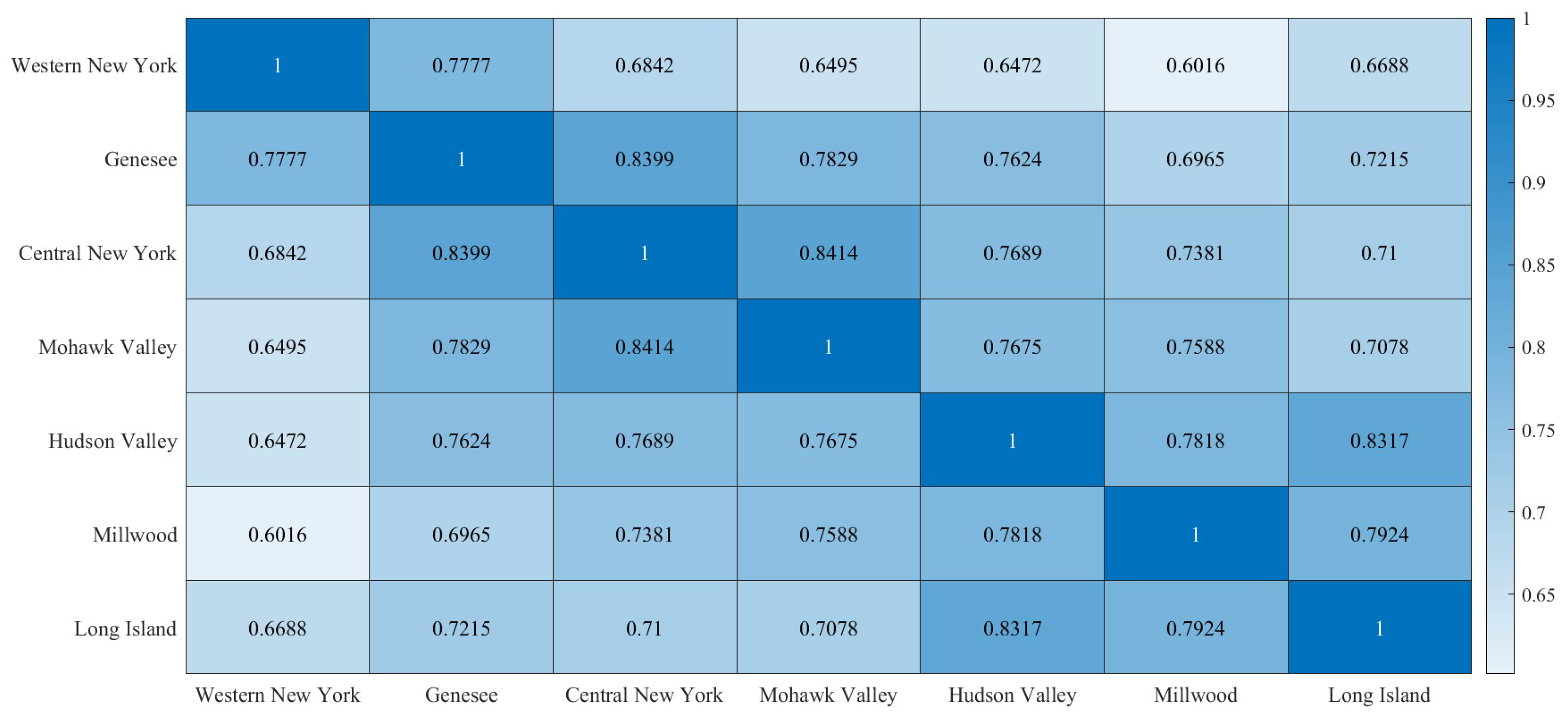
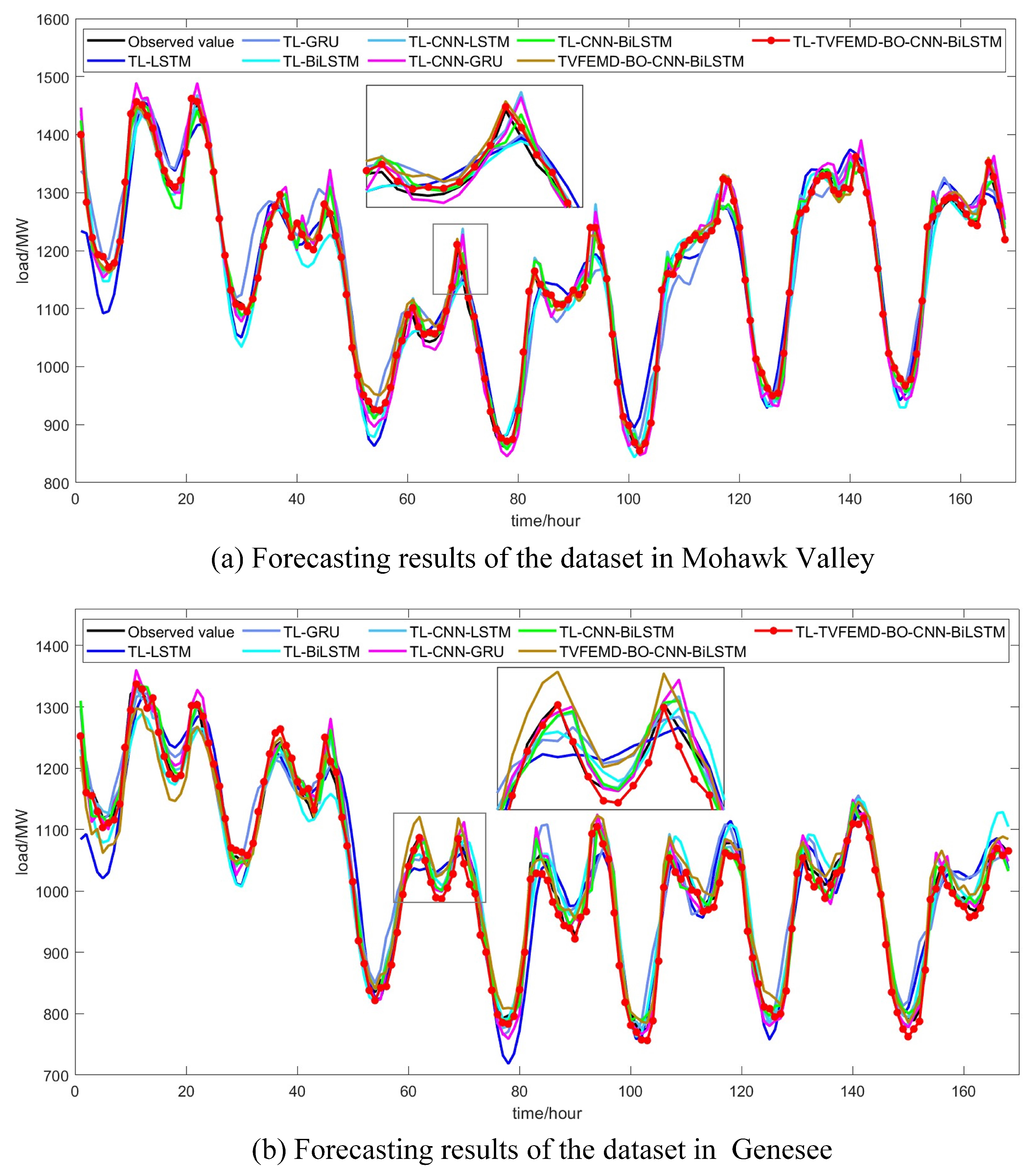
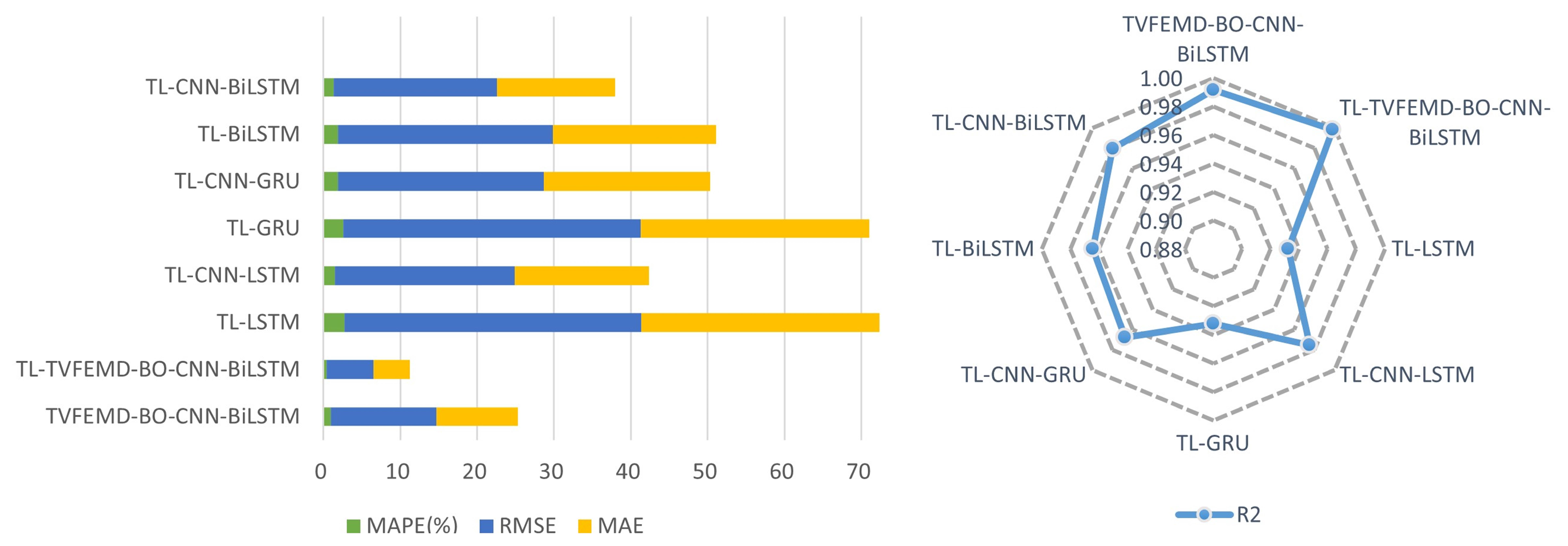
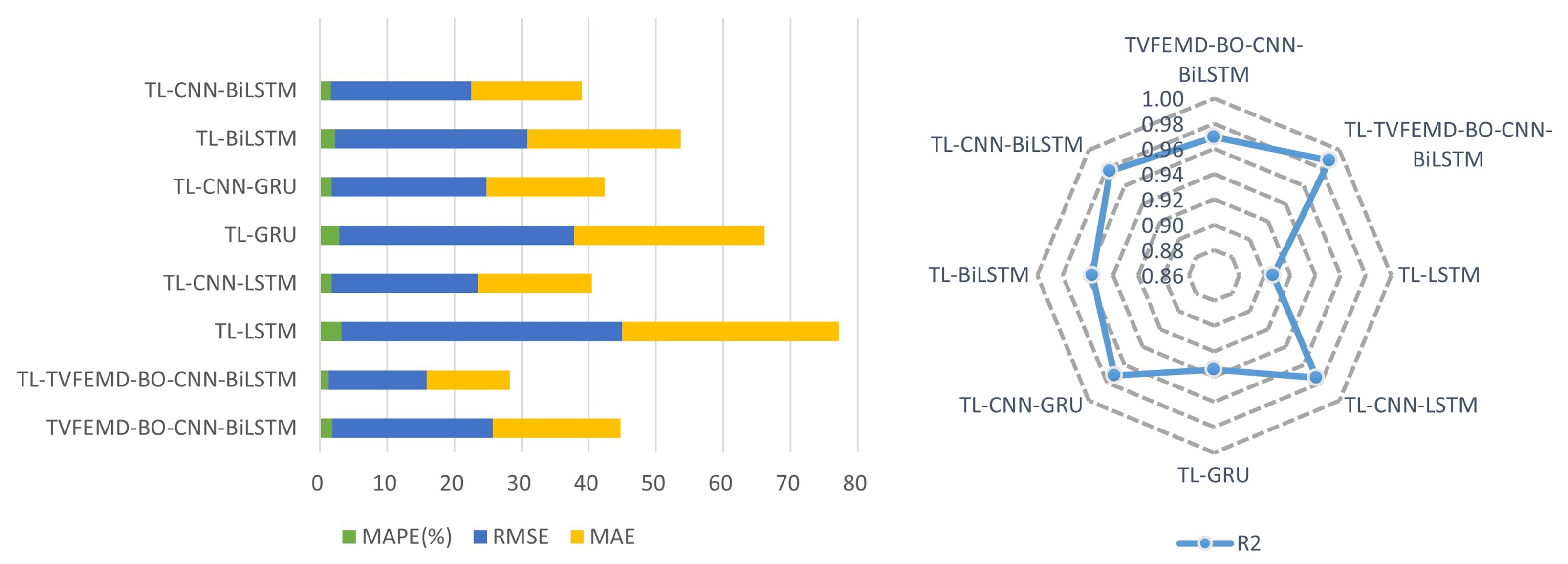
| Australian Dataset | Series | ||||||||||
| Sample entropy | 0.0759 | 0.0414 | 0.0318 | 0.0307 | 0.0172 | 0.0158 | 0.0131 | 0.0107 | 0.0074 | 0.0061 | |
| Reconstruction | |||||||||||
| Chinese Dataset | Series | ||||||||||
| Sample entropy | 0.2572 | 0.1575 | 0.1421 | 0.1103 | 0.0957 | 0.0927 | 0.0902 | 0.0711 | 0.0642 | 0.0517 | |
| Reconstruction |
| Model | Hyperparameter | Range | Australian Dataset | Chinese Dataset |
|---|---|---|---|---|
| Optimization Results | Optimization Results | |||
| CNN | numfilter | [2, 256] | 57 | 64 |
| sizefilter | [2, 4] | 3 | 2 | |
| Dropout | [0.01, 1] | 0.0208 | 0.0122 | |
| BiLSTM | MaxEpoch | [50, 100] | 42 | 16 |
| InitialLearnRate | [0.001, 0.01] | 0.0012 | 0.0016 | |
| LearnRateDropPeriod | [1, 100] | 8 | 5 | |
| LearnRateDropFactor | [0.1, 1] | 0.1010 | 0.1244 |
| Models | Dataset in Australia | Dataset in China | ||||||
|---|---|---|---|---|---|---|---|---|
| MAPE (%) | RMSE | MAE | MAPE (%) | RMSE | MAE | |||
| ELM | 2.3704 | 239.4930 | 192.9309 | 0.9550 | 5.5325 | 443.1403 | 345.2088 | 0.9176 |
| CNN | 2.3562 | 234.7214 | 188.2177 | 0.9568 | 4.9592 | 436.0833 | 320.7937 | 0.9202 |
| GRU | 2.2960 | 227.9039 | 185.9117 | 0.9592 | 4.5806 | 403.8322 | 293.3329 | 0.9316 |
| LSTM | 1.8397 | 216.0864 | 152.3165 | 0.9634 | 3.8580 | 360.6637 | 244.0518 | 0.9454 |
| BiLSTM | 1.9120 | 199.7428 | 160.5922 | 0.9687 | 3.2272 | 264.0626 | 199.9038 | 0.9708 |
| CNN-LSTM | 1.2892 | 134.8267 | 104.3219 | 0.9857 | 1.7995 | 157.0683 | 113.3924 | 0.9897 |
| CNN-BiLSTM | 1.2262 | 130.5426 | 102.5207 | 0.9866 | 1.7793 | 153.3386 | 112.1061 | 0.9901 |
| BO-CNN-BiLSTM | 1.1172 | 115.5108 | 93.0379 | 0.9895 | 1.6267 | 142.4330 | 101.9695 | 0.9915 |
| EMD-BO-CNN-BiLSTM | 0.8982 | 99.9201 | 74.0757 | 0.9922 | 1.1496 | 94.4236 | 70.0163 | 0.9963 |
| TVFEMD-BO-CNN-BiLSTM | 0.3893 | 39.3832 | 31.5929 | 0.9988 | 0.8289 | 50.96943 | 64.9864 | 0.9982 |
| Models | Dataset in Mohawk Valley | Dataset in Genesee | ||||||
|---|---|---|---|---|---|---|---|---|
| MAPE (%) | RMSE | MAE | MAPE (%) | RMSE | MAE | |||
| TL-LSTM | 2.7129 | 38.6663 | 30.9617 | 0.9323 | 3.1507 | 41.8600 | 32.1833 | 0.9066 |
| TL-GRU | 2.5766 | 38.6839 | 29.7569 | 0.9323 | 2.8379 | 35.0285 | 28.2472 | 0.9346 |
| TL-BiLSTM | 1.8608 | 28.0134 | 21.2605 | 0.9645 | 2.2195 | 28.6088 | 22.8857 | 0.9564 |
| TL-CNN-LSTM | 1.4982 | 23.3781 | 17.4889 | 0.9753 | 1.6499 | 21.8287 | 16.993 | 0.9746 |
| TL-CNN-GRU | 1.8703 | 26.8162 | 21.6318 | 0.9674 | 1.7202 | 23.0775 | 17.5707 | 0.9716 |
| TL-CNN-BiLSTM | 1.3157 | 21.2666 | 15.3652 | 0.9795 | 1.6039 | 20.9308 | 16.4696 | 0.9766 |
| TVFEMD-BO-CNN-BiLSTM | 0.9395 | 13.7319 | 10.5835 | 0.9915 | 1.8213 | 23.9374 | 18.9842 | 0.9695 |
| TL-TVFEMD-BO-CNN-BiLSTM | 0.4193 | 6.1317 | 4.6986 | 0.9983 | 1.2256 | 14.6354 | 12.4256 | 0.9886 |
Disclaimer/Publisher’s Note: The statements, opinions and data contained in all publications are solely those of the individual author(s) and contributor(s) and not of MDPI and/or the editor(s). MDPI and/or the editor(s) disclaim responsibility for any injury to people or property resulting from any ideas, methods, instructions or products referred to in the content. |
© 2024 by the authors. Licensee MDPI, Basel, Switzerland. This article is an open access article distributed under the terms and conditions of the Creative Commons Attribution (CC BY) license (https://creativecommons.org/licenses/by/4.0/).
Share and Cite
Xiao, L.; An, R.; Zhang, X. A Deep Learning Approach Based on Novel Multi-Feature Fusion for Power Load Prediction. Processes 2024, 12, 793. https://doi.org/10.3390/pr12040793
Xiao L, An R, Zhang X. A Deep Learning Approach Based on Novel Multi-Feature Fusion for Power Load Prediction. Processes. 2024; 12(4):793. https://doi.org/10.3390/pr12040793
Chicago/Turabian StyleXiao, Ling, Ruofan An, and Xue Zhang. 2024. "A Deep Learning Approach Based on Novel Multi-Feature Fusion for Power Load Prediction" Processes 12, no. 4: 793. https://doi.org/10.3390/pr12040793
APA StyleXiao, L., An, R., & Zhang, X. (2024). A Deep Learning Approach Based on Novel Multi-Feature Fusion for Power Load Prediction. Processes, 12(4), 793. https://doi.org/10.3390/pr12040793






